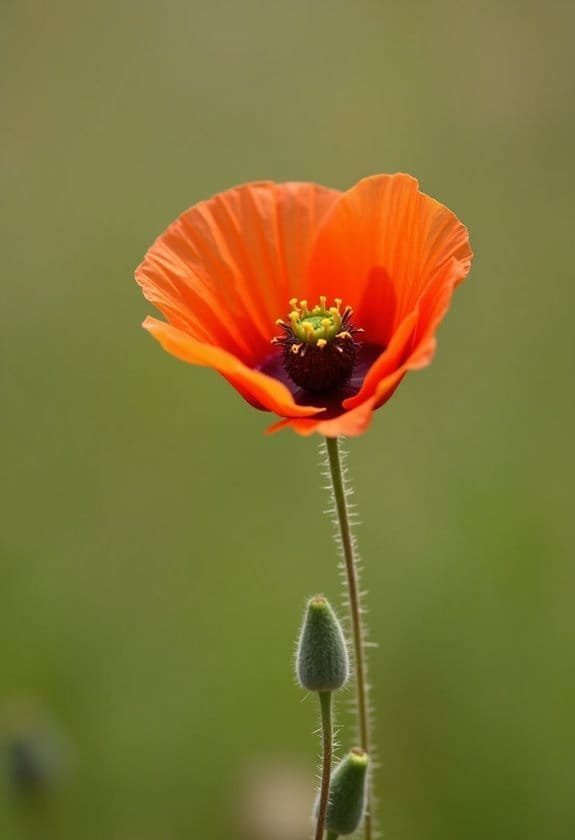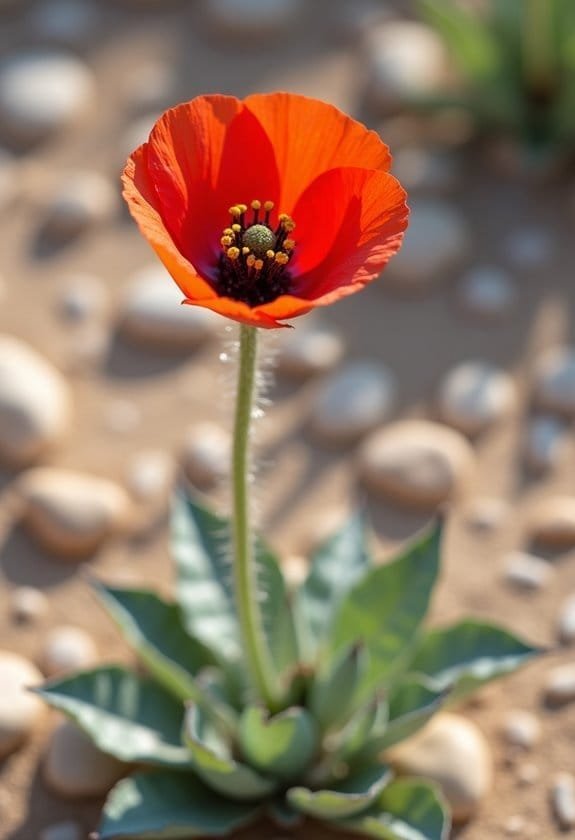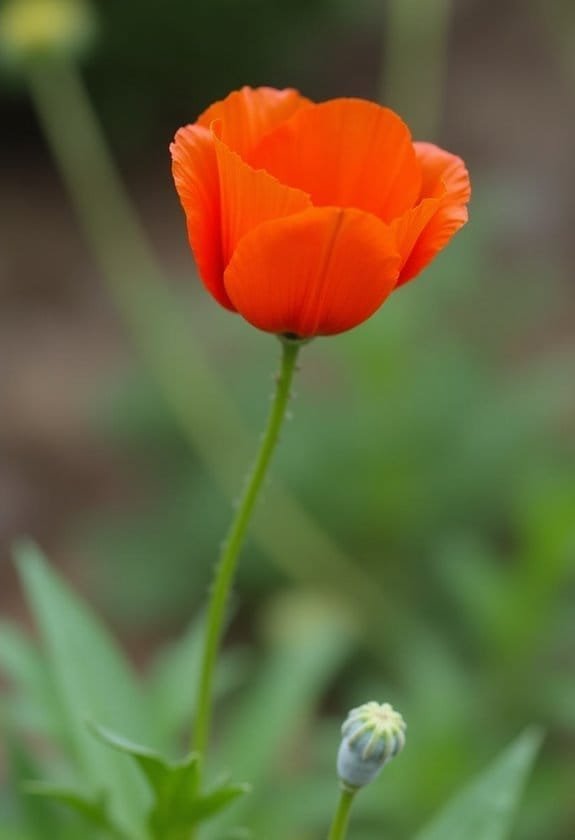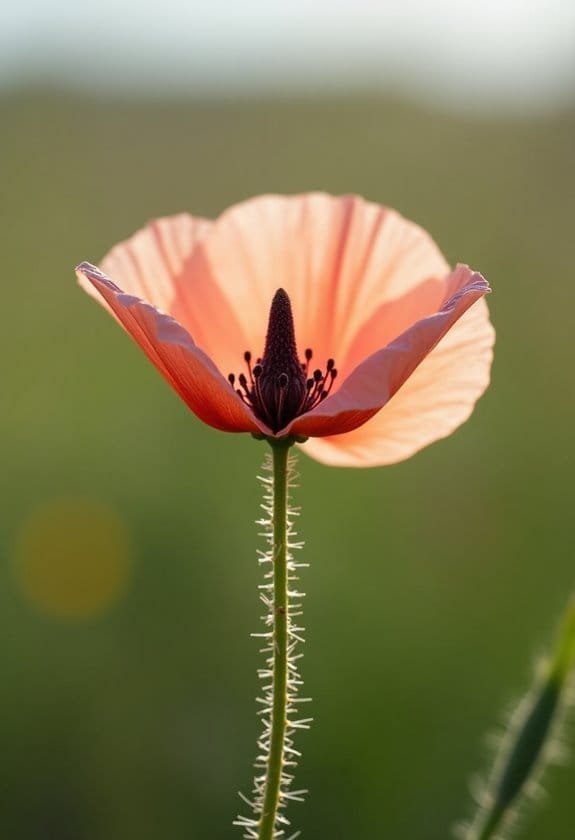The Long-headed Poppy (Papaver dubium) is a striking wildflower reaching heights of 30-90 centimeters, distinguished by its lighter red petals and elongated seed capsules. It's native to Europe, Asia, and North Africa but has naturalized successfully in North America, particularly thriving in disturbed soils and waste lands. The plant's coarse-haired stems support substantial blooms measuring 30-70 millimeters, which flower from May through July, attracting diverse pollinators including bees and beetles. While it's capable of producing up to 160,000 seeds per plant, its true significance extends beyond its reproductive capacity to its role in maintaining ecosystem biodiversity and soil health.
Main Points
- Long-headed poppy is a flowering plant reaching 30-90 centimeters tall with light red petals and elongated seed capsules.
- Native to Europe, Asia, and North Africa, it thrives in disturbed soils and has naturalized in North America.
- Plants bloom from May through July, producing between 5,700 and 160,000 seeds that remain viable for decades.
- It requires well-drained sandy or loamy soils, bright sunlight, and temperatures between 15-25°C for optimal growth.
- The species supports local pollinators like bees and beetles while establishing persistent seed banks in anthropogenic environments.
Introduction

The Long-Headed Poppy (Papaver dubium) stands as a striking annual wildflower that graces fields and roadsides across Europe, Asia, and North Africa.
This distinctive member of the Papaveraceae family showcases large, lighter red flowers measuring 30-70 mm in diameter, rising on stems that reach heights between 30 and 90 centimeters.
The plant's remarkable adaptability and its ability to establish long-lasting seed banks in the soil have contributed to its successful spread beyond its native range, including its naturalization in North America.
Common Name
Known scientifically as Papaver dubium, Long-Headed Poppy carries several common names across different regions, including Blaver, blind eyes, and cock. The variety in its common names reflects the plant's widespread recognition across different cultural and linguistic communities, particularly in its native to Europe regions where it has historically flourished.
The long-headed poppy's vernacular nomenclature often derives from its distinctive physical characteristics, particularly its striking flowers and growth patterns in agricultural landscapes. Unlike its close relative, the common poppy (Papaver rhoeas), this species is distinguished by its lighter red petals and the notable absence of black spots at the petal bases.
The plant's ability to establish itself in disturbed habitats, combined with its remarkable seed bank persistence, has contributed to its recognition among farming communities and botanists alike. These characteristics have made it a familiar sight in southern New England's anthropogenic environments, where it has become well-established in fields and waste areas, earning it various local names that reflect its adaptability to human-modified landscapes.
Scientific Name
Scientifically classified as Papaver dubium L., this flowering plant belongs to the Papaveraceae family and derives its name from Latin origins. The botanical nomenclature follows the standard binomial classification system, where "Papaver" designates the genus of poppies, and "dubium" specifically identifies this long-headed variety. The addition of "L." acknowledges Linnaeus, the botanist who first described the species.
Species differentiation within the Papaver genus requires careful attention to morphological details, as P. dubium shares visual characteristics with its close relatives. While it's frequently mistaken for the common poppy (P. rhoeas) or opium poppy (P. somniferum), its distinctive elongated seed capsules serve as a defining feature.
The scientific name's etymology reflects the plant's historical significance, with "Papaver" deeply rooted in ancient Latin culture and associated with sleep-inducing properties. This classification has proven particularly valuable in distinguishing the long-headed poppy from similar species across its native European and Southwest Asian range, as well as in regions where it has been introduced, such as North America.
Overview
Standing erect in disturbed soils and waste lands across Europe and southwest Asia, Long-headed Poppy (Papaver dubium) displays its distinctive pale red blooms from late spring through mid-summer. This resilient annual plant, reaching heights of approximately 60 centimeters, has established itself as a significant contributor to local ecosystems and biodiversity.
The species' most striking features include its large flowers, with petals spanning 30-70 millimeters, and its characteristic elongated capsule that produces a white to yellowish latex. While its cultural significance and medicinal uses haven't matched those of its cousin, the common poppy, its ecological benefits are substantial.
The plant's coarse-haired stems and unique reproductive strategy enable it to thrive in various habitats, where it serves as a valuable resource for pollinators and contributes to soil health.
Perhaps most remarkable is the species' ability to create a persistent soil seed bank, with seeds remaining viable for decades beneath the surface. This adaptation guarantees the plant's survival through environmental changes, emerging when soil disturbance creates favorable conditions for germination.
Key Features
The Long-Headed Poppy stands as a striking plant, reaching heights between 30 to 90 centimeters with its coarse-haired stem supporting prominent flowers.
Its distinctive blooms showcase lighter red petals measuring 30 to 70 millimeters, making it a noticeable presence in fields and disturbed soils during its flowering period.
The plant's peak display occurs from late spring through mid-summer, when its characteristic elongated seed capsules, filled with white to yellowish latex, become particularly visible.
Growth Size
Reaching heights between 30 and 90 centimeters, long-headed poppies showcase distinctive growth features that include coarse-haired stems and alternately arranged lobed leaves. The plant's growth patterns typically stabilize around 60 centimeters, demonstrating remarkable consistency across various environmental influences.
Notable height variations can be observed in the plant's prominent flowers, which develop impressive diameters ranging from 30 to 70 millimeters. These blooms display lighter red petals that characteristically lack the black basal spots commonly found in other poppy species.
The plant's robust structure supports elongated seed capsules that exhibit a distinctive obconic to obovoid shape, measuring two to three times longer than their width.
These dimensional characteristics directly influence the plant's reproductive capacity, with individual specimens capable of producing between 5,700 and 160,000 seeds. The stem's architecture efficiently supports this substantial reproductive load while maintaining structural integrity through its coarse-haired surface.
White to yellowish latex exudes from the hairless capsules, contributing to the plant's distinctive vertical profile and overall impressive stature in its natural habitat.
Appearance
Distinctive coarse hairs cover the stems of long-headed poppies, complementing their alternately arranged lobed leaves and light red to yellow flowers. These characteristic hairs contribute to the plant's unique tactile properties, setting it apart from other members of the Papaver genus.
The flowers command attention with their substantial size, displaying delicate petals that span 30-70 millimeters in diameter. Their color palette ranges from subtle yellows to vibrant reds, creating eye-catching displays in natural settings.
The plant's leaves exhibit a particularly remarkable arrangement, with their lobed structure growing alternately along the stem rather than clasping it, which serves as a key identifying feature.
Among the most distinctive elements of the long-headed poppy's appearance is its smooth, cylindrical seed capsule, which produces a distinctive white to yellowish latex when disturbed. This elongated capsule, coupled with the plant's impressive height of 30-90 centimeters, creates a striking silhouette that stands out in fields and meadows where these poppies typically grow.
Flowering Season
Springtime heralds the arrival of long-headed poppy blooms, which flourish from May through July in fields and meadows. During this peak flowering duration, the plant produces striking blossoms measuring 30 to 70 millimeters in diameter, displaying lighter red petals that typically lack the characteristic black spot found in other poppy species.
The flowering season maximizes the plant's reproductive potential through both self-fertilization and cross-pollination mechanisms. As temperatures warm and daylight hours extend, these impressive flowers become essential resources for various pollinators, including industrious bees, curious beetles, and opportunistic flies.
Standing at approximately 60 centimeters tall, the long-headed poppy creates a remarkable visual display that persists through the height of summer. The seasonal benefits of this flowering period align perfectly with peak pollinator activity, ensuring successful reproduction while contributing to the broader ecosystem's health.
This timing also allows the plant to complete its reproductive cycle before the arrival of late summer conditions, when environmental stresses might impact seed development and dispersal.
Growing Requirements

The Long-Headed Poppy thrives in bright, direct sunlight and requires well-drained, sandy or loamy soils that provide adequate aeration for its developing root system.
For peak growth, the plant needs moderate moisture levels during its establishment phase, though it demonstrates remarkable resilience to varying water conditions once mature.
These hardy annuals flourish in temperate climates with temperatures ranging from 15-25°C (59-77°F), making them particularly well-suited for spring and early summer cultivation in fields, gardens, and naturalized areas.
Light
Growing successfully in full sun to partial shade, long-headed poppies demonstrate remarkable adaptability to varying light conditions. This adaptability allows them to thrive in diverse habitats, from open fields to partially shaded roadside environments, where light intensity effects play a significant role in their development.
The plant's response to light duration impact becomes evident in temperate climates, where it synchronizes its flowering period with the lengthening days of late spring through mid-summer. These poppies have evolved to optimize their light spectrum preferences, efficiently utilizing available sunlight for photosynthesis across different environmental conditions.
In anthropogenic settings, where building shadows and artificial structures may create varied light patterns, the species maintains its resilience. Their ability to persist in disturbed areas suggests that light availability isn't a limiting factor in their establishment, as they can adjust their growth patterns according to local conditions.
This remarkable light tolerance contributes to their success in colonizing new territories, making them particularly well-suited for both natural and human-modified landscapes where light conditions may fluctuate throughout the growing season.
Soil
Successful cultivation of long-headed poppies depends heavily on well-drained sandy or loamy soils that mirror their natural habitat preferences. These adaptable plants demonstrate remarkable versatility across various soil types, thriving in both light and heavy compositions while maintaining their characteristic resilience.
The species' relationship with soil extends beyond mere growth requirements, as it establishes an impressive seed bank that can remain viable for decades beneath the surface. When soil disturbance occurs, whether through natural processes or cultivation, these dormant seeds spring to life, taking advantage of newly exposed growing conditions.
To optimize growing success, careful attention to surface retention of seeds proves crucial, while shallow spring cultivations help manage the delicate balance of the soil ecosystem. This strategic approach to soil management guarantees that dormant seeds remain undisturbed while allowing newly scattered seeds to establish themselves effectively.
The plant's ability to persist in various soil conditions, coupled with its seed banking strategy, makes it a particularly successful colonizer of disturbed areas and agricultural fields.
Water
While soil composition provides the foundation for long-headed poppy growth, proper water management plays an equally important role in cultivating these resilient plants. These adaptable annuals have developed sophisticated water conservation strategies that enable them to thrive in varying moisture conditions, particularly in well-draining environments.
The long-headed poppy's natural drought resistance techniques allow it to withstand moderate dry spells, though it performs best with consistent moisture during its critical flowering period from late spring through mid-summer. Implementing effective moisture retention methods becomes crucial during this reproductive phase, as adequate hydration supports robust flower development and subsequent seed production.
The plant's relationship with water extends beyond immediate growing needs, as seasonal rainfall patterns influence seed germination cycles, particularly when soil disturbance occurs. During their relatively brief lifecycle, these poppies demonstrate remarkable efficiency in water utilization, balancing their immediate growth requirements with long-term survival strategies.
This evolutionary adaptation guarantees that even in years with variable precipitation, the species can maintain viable seed banks in the soil for future generations.
Temperature
Temperature management plays a vital role in the long-headed poppy's development cycle, with these resilient plants thriving in temperate zones where daytime temperatures range from 15°C to 25°C (59°F to 77°F).
The plant's temperature resilience allows it to adapt to various environmental conditions, though careful monitoring during significant growth phases remains essential.
One of the most notable temperature effects occurs during the autumn germination period, when emerging seedlings face potential frost damage. While mature plants demonstrate remarkable adaptability to temperature fluctuations, young specimens require protection during these vulnerable stages.
The plant's ability to establish itself in disturbed areas showcases its impressive temperature tolerance, though ideal growth depends on maintaining consistent moderate temperatures.
Understanding these temperature requirements becomes particularly important for cultivation success, as the long-headed poppy balances delicately between cold tolerance and heat sensitivity.
Like a well-calibrated thermometer, these plants respond to their environment's thermal cues, adjusting their growth patterns accordingly.
This environmental responsiveness helps explain their widespread distribution across temperate regions, where moderate climatic conditions support their natural lifecycle.
Pollinator Criteria
The long-headed poppy's vibrant orange blooms serve as beacons for a diverse array of pollinating insects, including bees, beetles, and flies.
While the plant maintains self-fertility capabilities, cross-pollination through these insect visitors greatly enhances genetic diversity and overall population health.
The striking flowers, spanning 30-70 mm in diameter, produce both nectar and pollen rewards that sustain local pollinators throughout the late spring and mid-summer blooming period.
Attracted Pollinators
Pollinators flock to the long-headed poppy's vibrant blooms from late spring through mid-summer, with bees, beetles, and flies being the primary visitors. The species' pollinator preferences reflect its evolutionary adaptation to attract a diverse range of insects, enhancing its ecological importance within local ecosystems.
The plant's attraction strategies include its conspicuous flowers and the production of nutrient-rich latex, which serves as an additional enticement for particular pollinators seeking supplementary resources. While the flowers are self-fertile, the presence of multiple pollinator species notably contributes to genetic diversity through cross-pollination, strengthening the population's resilience.
The long-headed poppy's success in colonizing disturbed areas plays a vital role in its relationship with pollinators, as its increased visibility makes it an easily accessible food source.
This adaptability creates a mutually beneficial arrangement where the plant's reproductive success is enhanced while providing essential sustenance for various insect species during peak pollination periods, contributing to the broader ecological network of plant-pollinator interactions in the environment.
Pollination Method
Successful pollination of the long-headed poppy relies on specific criteria that match its reproductive strategy. While the plant maintains self-fertility capabilities, its pollination strategies strongly favor cross-pollination through insect interactions, which greatly enhance genetic diversity within populations.
The plant's distinctive orange blooms, remarkably lacking the black basal spots found in related species, serve as powerful attractants for specific pollinators during its strategic flowering period from late spring to mid-summer. Bees, beetles, and flies respond to these visual cues, facilitating the transfer of pollen between different plants as they forage.
The timing of flower production coincides precisely with peak pollinator activity, maximizing the effectiveness of these essential interactions.
This sophisticated approach to reproduction yields impressive results, with individual plants capable of producing between 5,700 and 160,000 seeds following successful pollination. The combination of self-fertility and insect-mediated cross-pollination provides the species with reproductive flexibility, ensuring survival under various environmental conditions while maintaining beneficial genetic variation within populations.
Care & Maintenance

Successful cultivation of long-headed poppy starts with selecting well-drained, sandy or loamy soil in a location that receives abundant sunlight throughout the growing season.
While the plant exhibits impressive drought tolerance once established, gardeners should maintain consistent moisture during the critical germination phase and early growth stages.
Companion planting with drought-resistant perennials creates an effective garden design, though careful management of soil disturbance remains essential to prevent uncontrolled spread through seed dispersal.
Planting Tips
When it comes to planting long-headed poppies, proper soil preparation and placement are fundamental for success. The planting techniques for these delicate annuals begin with selecting a well-drained location that receives full sunlight throughout the day, as these conditions closely mirror their natural habitat preferences.
For ideal seed preparation, gardeners should deliberately disturb the soil surface before sowing, which triggers the seeds' natural germination response. While the plants will eventually become drought-tolerant, it's important to maintain consistent soil moisture during the critical establishment phase.
Site selection plays an essential role in the success of long-headed poppies, with sandy or loamy soils providing the best growing medium for their development. To guarantee robust growth, incorporate integrated pest management strategies from the beginning, as these plants can attract various insects during their growth cycle.
The seeds should be scattered across the prepared area, then lightly covered with soil, as they require some light for germination. While these poppies are relatively low-maintenance once established, their initial planting phase demands attention to detail and careful monitoring.
Ongoing Care
After establishing long-headed poppies in your garden, maintaining ideal growing conditions becomes the key focus. Successful growing techniques emphasize proper soil management, which includes regular monitoring of the well-drained sandy or loamy substrate to guarantee prime moisture levels and nutrient availability.
Regular garden maintenance involves strategic thinning of seedlings to prevent overcrowding, allowing each plant sufficient space to develop its characteristic flowering structure.
Spring cultivation practices, performed at shallow depths, help manage the persistent seed bank while promoting controlled growth patterns throughout the growing season. The long-headed poppy's tendency to self-seed requires vigilant monitoring to prevent uncontrolled spread.
An essential aspect of ongoing care involves pest monitoring, with particular attention to gall midge infestations that can compromise seed capsule development.
Creating an environment that attracts pollinators, particularly bees and beetles, enhances seed production through improved outcrossing. Gardeners should establish a routine inspection schedule to identify potential issues early, enabling prompt intervention when necessary.
This proactive approach to maintenance guarantees healthy plant development and sustained flowering success throughout the growing season.
Suggested Companions
Selecting compatible companion plants for long-headed poppies requires careful consideration of shared growing requirements and spatial needs. The key to successful companion planting lies in choosing flowers that thrive in well-drained, sandy or loamy soils similar to those preferred by Papaver dubium.
Drought-tolerant companion flowers, such as lavender and yarrow, work exceptionally well alongside long-headed poppies, as they help maintain consistent soil moisture levels without creating competition. For optimal biodiversity enhancement, gardeners should consider incorporating plants that attract similar pollinators, including salvias and native wildflowers, while maintaining the recommended 30-45 cm spacing between specimens.
These thoughtful combinations create a vibrant ecosystem that supports various beneficial insects and promotes natural pest control.
To guarantee soil compatibility and prevent overcrowding, it's crucial to group long-headed poppies with plants sharing similar cultural requirements. Mediterranean herbs like rosemary and thyme make excellent companions, as they adapt well to the same growing conditions and contribute to the garden's overall architectural interest while maintaining proper air circulation necessary for disease prevention.
Are Coltsfoot Plants Similar to the Long-Headed Poppy in Their Habitat and Growing Conditions?
Coltsfoot plants and long-headed poppies differ notably in their habitats and growing conditions. While coltsfoot thrives in moist, disturbed soil and shaded locations, long-headed poppies prefer well-drained, sunny areas. For a detailed understanding of their unique characteristics and needs, a coltsfoot plant overview becomes essential in drawing these distinctions effectively.
Common Issues
Long-headed poppy faces several significant challenges in agricultural settings, where its invasive nature and resilient seed bank make it a formidable competitor against cultivated crops.
Pest-related issues are relatively minimal, though aphids and leaf miners occasionally target the plant's foliage during spring growth periods.
The most effective solutions include implementing strategic cultivation techniques and maintaining vigilant monitoring systems, particularly in areas where the plant's ability to spread rapidly poses risks to native species and crop yields.
Pests/Diseases
Like many garden plants, the long-headed poppy faces several challenging pests and diseases that can impact its health and development. One of the most significant threats comes from the gall midge, Dasyneura papaveris, which specifically targets seed capsules and compromises the plant's reproductive success through reduced seed viability.
Various pest management strategies and disease prevention techniques become essential when dealing with common infestations such as aphids, which can severely affect the plant's vigor by feeding on its sap.
In humid conditions, powdery mildew can establish itself on the foliage, creating a dusty white coating that diminishes both the plant's health and its ornamental value.
Root rot presents another serious challenge, particularly in gardens with poor drainage or overwatering practices, often leading to irreversible damage or plant mortality.
While some gardeners experiment with herbal remedies' efficacy, the most reliable approach combines vigilant monitoring with cultural controls.
Implementing proper spacing for adequate airflow, ensuring well-draining soil conditions, and practicing crop rotation have proven most effective in maintaining the long-headed poppy's health and resilience against these various threats.
Solutions
Common management solutions for long-headed poppy issues center on prevention and targeted control methods. Effective management strategies focus on minimizing the plant's ecological impact while protecting valuable agricultural lands and native plant communities from invasion.
Shallow spring cultivation serves as a primary mechanical control method, effectively eliminating emerged seedlings without disturbing deeper soil layers where dormant seeds reside. This approach, when combined with soil solarization techniques that raise soil temperatures to lethal levels, creates a thorough defense against both active and dormant poppy populations.
Surface seed retention proves particularly valuable, as it encourages synchronized spring germination that makes subsequent control efforts more efficient.
For long-term population management, the introduction of biological control agents, specifically the gall midge Dasyneura papaveris, offers a sustainable solution by disrupting seed production cycles. This tiny insect targets developing seed capsules, greatly reducing the plant's reproductive capacity without causing harm to surrounding vegetation.
When implemented together, these varied control methods create a robust integrated approach to managing long-headed poppy infestations.
Summary

Within the diverse family of poppies, Papaver dubium stands out as a resilient annual plant known for its pale red blooms and impressive height of 30-90 cm. Its cultural significance and ecological impact have been documented across Europe and southwest Asia, where it has historically adapted to thrive in disturbed landscapes and agricultural settings.
The plant's remarkable survival strategy lies in its ability to maintain a persistent seed bank, with seeds remaining viable for decades beneath the soil surface. Its historical uses, while less prominent than some of its poppy relatives, have contributed to local agricultural traditions and botanical studies.
The Long-headed Poppy's self-fertile nature and attraction to various pollinators make it an important contributor to ecosystem diversity, particularly in disturbed habitats. The species' distinctive flowers, measuring 30-70 mm in diameter, lack the characteristic black spots found in related poppies, setting it apart in botanical identification.
As an adaptable annual that's found success in various regions, including southern New England, Papaver dubium exemplifies the resilience and reproductive strategies that have enabled certain plant species to flourish alongside human development.


